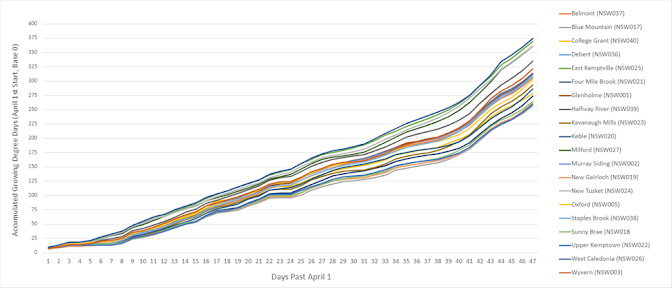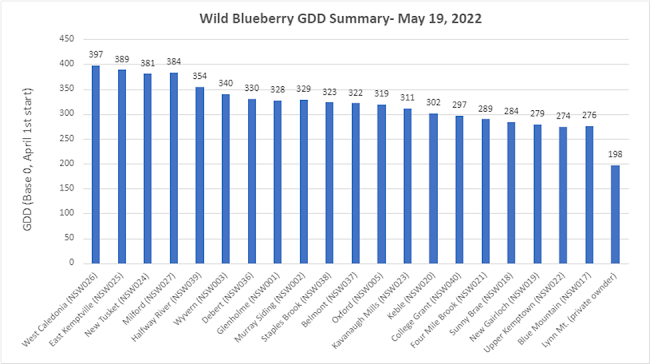BLUE
FOCUS NEWSLETTER- May 2022
(Perennia’s
Wild Blueberry Newsletter)
Dear Growers,
We are fast approaching bloom and
pollination season and we are expecting to see beehives out in crop fields this
long weekend. In sprout fields, plant emergence ranges from 10% to 50% and most
of you should finish spring herbicide treatments by now as it is late to put
any herbicides that would damage blueberry plants. Please see the details
below.
Thank you for your ongoing support!
Have a great long weekend!
Hugh Lyu
Wild Blueberry Specialist, Perennia
hlyu@perennia.ca; 902-890-0472.
May 20, 2022
Table of Contents:
NS Wild Blueberry Production Update
Upcoming Management Recommendations
Insect Traps
Upcoming Events
NS Wild Blueberry Production Update
Plant Development and Growing Degree Days in 2022 (NS)
If you remember what the season was like in 2021, you
are experiencing the same development trend for this season! Fast plant
development!
The figure and table below summarized growing degree
days from a weather station in Kentville. From March 1 to May 16, we are in a similar
GDD and development trend as 2021 and certainly above the 5-year average in
plant development.
Figure 1. Degree Days
Accumulations as of May 16, 2022, Kentville weather station, Provided by Jeff
Franklin (AAFC)
|
Category |
2019 |
2020 |
2021 |
2022 |
5 year average |
10 year average |
|
Plant
development (Base 5ºC) |
155.0 |
113.7 |
210.6 |
196.9 |
175.8 |
184.3 |
|
Insect
development (Base 10º) |
43.6 |
22.8 |
70.2 |
60.5 |
58.2 |
66.1 |
In
wild blueberry fields, we observed fast development after we got into May and
especially in the last two weeks. I have seen fields go from 30% F2 to 50% F2
in two days and one of the reasons is the increase of heat accumulation in the
soil. We also observed that it took a very short time for plants to develop
from bud stage (F2, F3 and F4) to bloom stage (early flower stage, pre-bloom).
Normally from 80% F2 to bloom stage, it would take another week but this year,
they advanced very fast. I heard comments from growers: “I don’t think I saw
blueberries advance this fast!”.
More
direct data and information on wild blueberries: the below figure (Figure 2)
shows how fast and many GDD accumulated in the last 7 days.
Although
we are excited about dry and warm weather during the monilinia blight season,
the fast development trend means when we get into bloom and pollination season
earlier and we might be getting a higher frost risk if there are low
temperatures during the full bloom period.
Figure 2. GDD accumulation since April 1 from weather stations in wild blueberry fields.
Figure 3 shows the most current (as of May 19) GDD
summary from weather stations in wild blueberry fields. As I said, when we
compare those numbers to the wild
blueberry GDD model, we are looking at 10% to 50% plant
emergence in sprout fields. In crop fields, stems with open flowers just
started but some areas are getting into 10% to 25% bloom.
I hope you have a chance to check and use this new GDD
tool
we developed this year and get something out of it to help with your
management.
Figure
3. Wild Blueberry GDD Summary, May 19, 2022
*Lynn
Mt station was up to date as of May 11.
Winter Damage and Yield
Potential in 2022
As I mentioned in April’s newsletter, we observed
minimal winter damage in early spring and by far, everything seems to be
cooperating. We are seeing great yield potential from fruit bud numbers and
sizes. We all look forward to a great year!
I also heard from a few growers about their feelings
towards this year, “So far, everything is going very well and I am seeing great
yield potential in my fields. I would say this is probably the best year in 6
years.”
Overwinter Beehive Health
Since my last update about this topic, I didn’t hear
many new updates about overwinter beehive damage. We know we had a higher
percentage of winter losses compared to previous years, but the damage level is
in an acceptable range in NS. In other regions, getting sufficient pollination
is going to be a challenge this year. We are expecting a full report on
overwintering beehive damage by mid-June, and I will update this in June’s
newsletter.
Monilinia Blight
This year, I continued to give % of
F2 updates on fields I visited and information getting from
growers and farm staff. Thank you to those who shared information with the
industry. We are getting to the end of monilinia blight infection season for
this year and we did observe some infection periods through the susceptible
period. We haven’t seen symptoms yet, but we should start to find leaves and
blooms with infection if fields didn’t get treatments or applications were made
at the wrong timings.
Other in-field
observations
There are two things I like to share from observations
made by myself and others.
During F2 scouting, I saw some fields with patches of
blueberry stems with damaged and brown flowers and fruits. This is likely due
to the late fall flowering of the previous sprout year. We observed plants
producing buds and flowers in the late fall last year in sprout fields. This is
not in a high percentage of fields in the province and I only saw this in a
couple of fields I visited but worthwhile to share and bring this to your
attention.
Figure
4. Damaged flowers and fruits from previous fall late development stems
This year, we also saw blueberry emerge from cut stems
that were buried under snow and got protection from snow coverage. This early
plant emergence could affect spring herbicide application timing.
Figure
5. Blueberry emergence from cut stems
Upcoming Management
Recommendations
Crop fields
Pollination
is the main priority after this long weekend towards June. Please start your
communication with your beekeepers and make sure you talk to them if you decide
to spray any products when bees are in the fields.
Botrytis Blight:
If you are in areas where typically more prone to botrytis infection, such as
coastal areas, wet/fog areas and if your fields are weedy (sheep sorrel is an
important host) with very dense patches, you should consider and monitor the
situation for treatment application. The fungus begins to sporulate at early
bloom, so the best time to apply (if needed!) the first application is when
about 30-40% of the flowers are open. Closed flowers are resistant to
infection. A second spray can be applied about 7-10 days later.
Insects: trapping and monitoring
concerned insects in your areas and fields. Please see the information below
for places you can get traps.
Sprout fields
Weed control:
spot treatments and mechanical weed control (pull or cut weeds above the
blueberry canopy before plants produce seeds).
Leaf disease control:
considering and planning leaf disease control, such as Septoria leaf spot, leaf
rust and powdery mildew. Please check out our 2022 pest guide to find products
to help with your management: https://www.perennia.ca/wp-content/uploads/2018/03/Wild-Blueberry-Pest-Guide-2022_FINAL.pdf.
Insect Traps
Some of you might start thinking about getting insect
monitoring traps early due to supply chain delays. WBPANS carries traps in the
office, so please give them a call and check if you can get the things you need
(902-662-3306; info@nswildblueberries.com).
Great Lakes IMP (https://www.greatlakesipm.com/)
also has great selections of monitoring tools.
Upcoming Events
Please check out the event page under
the wild blueberry blog for more details. http://www.novascotiawildblueberryblog.com/p/events.html
Perennia- Weather
Station Apps and Website Training Session (online)
Date and time: May 24, 2022 (Tuesday), 7-8:30
pm
This training session is intended for producers who
have purchased weather stations from Perennia under the Nova Scotia Weather
Station Assistance Program but is open to anyone who would like to learn more
about weather stations and how they work. It will provide an overview of the
Davis weather station components, basic maintenance and using the apps and
software tools.
To register https://www.perennia.ca/eventer/weather-station-apps-and-website-training-session/edate/2022-05-24/.
WBPANS- 2022 Twilight
Meetings
Session 1: May 31, 2022, 6-8pm
Location: 168 Dakota Rd, Debert, NS
(WBPANS office)
Demonstration
of UAV, prescription map and modified sprayer system from the CWBIRDI
PAN-Atlantic project. Dr. Percival and his team will demonstrate the work of
the UAV system, the creation of in-field prescription maps and how the modified
sprayer can use these maps to apply pesticides precisely to a wild blueberry
field. Growers will see how these systems work and have the opportunity to ask
questions about how they could be used.
Session 2: June 7, 2022, 6-8pm
Location: TBD
Demonstration and discussion of weather station use in
wild blueberry fields.
More details to share once WBPANS releases the
information.
WBPANS- 2022 Field Day
Date: July 19, 2022
Location: 648 Sherbrooke Road, East River
Saint Marys, NS (John Cameron’s receiving shed)
WBPANS will host the 2022 Field Day on Tuesday, July
19, 2022, at John Cameron's receiving shed in East River Saint Marys, NS (648
Sherbrooke Road). The Field Day will return to an in-person format for 2022
with equipment & agri-business displays and field tours. Stay tuned for
more details!






